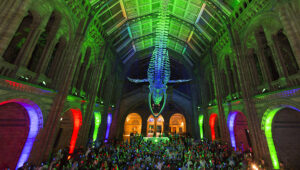Museums in the online age
In the UK, visits to museums are decreasing year on year across all categories, including a 6.9% decrease in educational visits and on-site activities for under-18s. Meanwhile, technology and the internet are playing a rapidly increasing role in our lives. A superficial reading of this would suggest that museums and galleries are in battle with the online world, but a closer look shows how the two can work in tandem to improve the public’s understanding of and interaction with the past.

Historians are often viewed as part of the past, along with misconceptions over what historians do. But historians are more aware than most of the power of social change. Historical study and preservation can enhance quality of life, promote tourism and encourage economic development.
History museums have always been faced with the difficult task of joining together academic history and the public. They risk being accused of being superficial and unrepresentative of historical events by academics, whilst also risking being viewed as dull or inaccessible by the general public. The social justice movements of 1960s and 1970s prompted the move to studying histories of people from below, rather than focusing on the “great men” depicted in Thomas Carlyle’s work.
“History from below” requires viewing history as an evolving social terrain where the authority of academics can meet the experience and views of the public, an approach named “shared authority” by Michael Frisch in the 1990s. Historians are increasingly part of a discussion around skills, public engagement and the value of scholarship. The internet has changed the way historians interact with academia, each other and the public, especially as people are now able to create history through digital means.
Museums are typically seen as passive spaces, where audiences passively absorb the information provided. Whilst interactive displays are increasing, lack of funding is preventing museums developing these to their full potential. Initiatives such as Museum Selfie Day and museum and gallery Lates break this passivity and help audiences feel more at home and involved in museums and galleries, where previously they may have felt unwelcome. Whilst such initiatives have been criticised for removing historical objects from their context and fetishising them, they also generate more free publicity than historians could dream of, whilst also increasing museum attendance in a time of funding cuts.
Academics themselves are embracing the online world, with increasing numbers of journals and books available online, and sometimes for free. Blogging, such as History@Work provides opportunities for historians to discuss their thoughts and findings with each other and with the public at a higher rate and speed, and for less expense, than the traditional spaces of discussion of journals and conferences.
The internet should be seen as a land of opportunity for museums rather than a threat. It provides the opportunity to reach new audiences and develop new lines of historical enquiry and methods of doing history. Such opportunities are ever more important when funding is being cut, and the need for open conversation and independent thought about our past is necessitated by the spread of dangerous rhetoric.
Josephine Kemp
Martin Tripp Associates is a London-based executive search consultancy. While we are best-known for our work across the media, information, technology, communications and entertainment sectors, we have also worked with some of the world’s biggest brands on challenging senior positions. Feel free to contact us to discuss any of the issues raised in this blog.